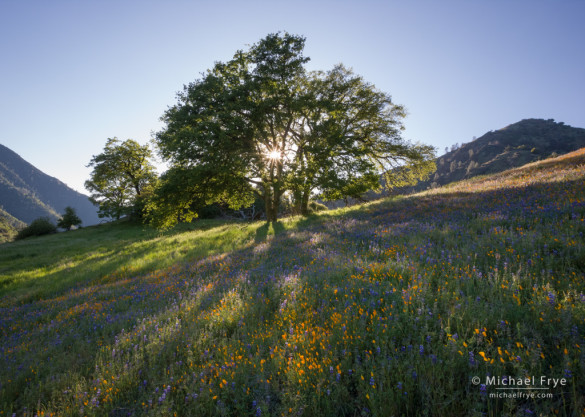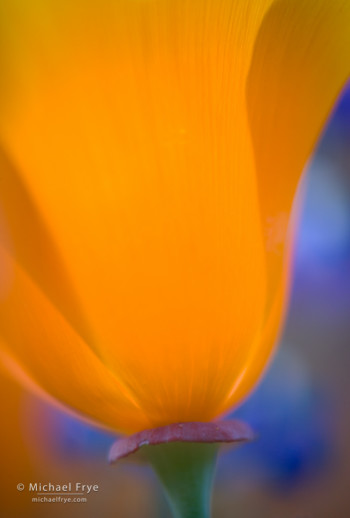I made the photograph above yesterday, and I’m sure many of you will notice the similarity between this image and one I posted two weeks ago. These are the very same trees, and again I’ve used the radiating pattern of the shadows. When I went back to this spot yesterday there were more poppies mixed with the lupine, and the trees had new leaves. So I worked on the same idea, but with different conditions.
I’m not afraid to repeat myself if I think I might be able to improve on a previous photograph. Sometimes I just don’t execute the photograph perfectly on the first try. Other times the conditions are better the second or third time around. What are the odds that you’ll visit a place for the first time and find perfect conditions? Pretty slim, I’d say. And the more times you visit a location, the more you’ll see, and the better you’ll understand how the light changes and affects the area at different times of day.
Is this new version of the oaks, flowers, and shadows, better than the previous one? That’s hard to say. I’ll have to let them sit for awhile until I can look at them with fresh eyes. But I wouldn’t have that choice unless I tried again.
As you can see from these photographs, there are still flowers in the Merced River Canyon west of Yosemite. About half the redbuds are still in good condition, but they’re leafing out rapidly, and won’t last long. As for poppies, the spots where they bloomed earliest, like the beginning of the Hite’s Cove Trail, have faded, but there are still a few good patches around, mainly at the eastern end of the canyon near El Portal. It’s likely that these will also fade within a week or so.
Other flowers will continue to bloom in the canyon for at least another month, but these late-season blossoms usually don’t form dense patches, and are better suited to closeups than to broader landscape images. I got into closeup mode for awhile yesterday, as you can see from this poppy photograph. It’s not often that I get into this mode, but flowers can offer a lot of creative opportunities, especially if you concentrate on the forms, shapes, and colors. This often means photographing a part of a flower, rather than trying to include the whole thing.
The next major bloom to look forward to is the dogwoods in Yosemite Valley. They typically start blooming around the end of April, but if we have warm and dry weather they could begin earlier than that. The deep-rooted dogwoods shouldn’t be affected by our dry winter, so let’s hope it’s a good year for them.
— Michael Frye
Related Post: Surprising Wildflowers
Michael Frye is a professional photographer specializing in landscapes and nature. He is the author and photographer of The Photographer’s Guide to Yosemite, Yosemite Meditations, and Digital Landscape Photography: In the Footsteps of Ansel Adams and the Great Masters, plus the eBooks Light & Land: Landscapes in the Digital Darkroom, and Exposure for Outdoor Photography. He has written numerous magazine articles on the art and technique of photography, and his images have been published in over thirty countries around the world. Michael has lived either in or near Yosemite National Park since 1983, currently residing just outside the park in Mariposa, California.











Thanks, Michael, for reminding us that returning to the same place repeatedly can be really rewarding. I really appreciate the closeup too. I’ll have to try looking for some good closeup options the next time I am out. I like the shape and colors in your photo. Really nice,
tom
Thank you Tom! Yeah, it’s worth looking for those closeups sometimes. 🙂
That closeup is definitely worth it. Beautiful colors and form. Certainly unique.
Re the two views of the trees — while I like the vertical angle. the more focused radiating pattern of the shadows and the violet/purple flowers in the foreground — if I could keep only one, I’m personally more drawn, long-term to the newer one because of the richness of the green of the new leaves and the warmer feel of the sunlit areas, accentuated by the orange of the poppies, all of which make me want to be there.
Really appreciate your writeups and background of your shooting.
Andrys, thanks for the kind words, and for your chiming in about which photo you like better. I probably lean toward the newer one too, but it’s a close call, and, as I said, I probably need to come back to these again with fresh eyes.
Hello. I really like the Poppy photo. I like how the petals seem to glow, the detail and the soft focus blue on the side. Great job.
Thanks very much Bill!
Michael,
As Heracles said a long time ago, “You can’t step in the same river twice.”.
If you go back to take the same picture, it won’t be the same. We all have places that mean something to us, that we want to see in another light. Thank you for reminding us.
PS great photos.
Made a mistake, spelling was never my best, it was Heraclitus
Well I never could have spelled it off the top of my head. 🙂 Thanks Tom.
Dear Michael,
iLife the warmth and pop of color the poppies add to this scene. I think I like the vertical orientation of the other shot better, but perhaps you wanted to accentuate some of the differences? It’s nice when we can return to a scene and have better conditions, or execute our craft better. Another advantage of being local!
Thank you Vivienne. I also composed some verticals the other day, but liked the horizontal best, as it accentuates the radiating lines.
I like to go back to the same places, but I have to be careful of having preconceived ideas because many times I’m let down or come back with a completely different composition. However, going back to the same spot makes you more observant and gives one a sense of place. Right now I”m in IL wondering why I”m not back in El Portal enjoying the spring colors. Michael I”m impressed how you get out and keep getting stellar images. Oh and I took my class of El Portal School students up to this very spot and they did not want to come down. Hopefully there is a future botanist in my class. I can’t wait to come home!
Hugh, you and I are both wondering why you’re in Illinois. 🙂 But I’m glad you took your students up there — they’re lucky to have you as a teacher!
I believe I like the second image slightly better. Mainly I like the composition better horizontal. The tree is a toss-up, bare or green, but the green does add a little warmth as someone else said. Also, it seems like there are slightly more flowers in the second version, which liven it up a bit.
Thanks for chiming in here David. I like the horizontal too — it feels more expansive. (It helps to view it larger.)
That picture of the sunstar through the tree is beautiful. Very striking, and you don’t need crazy clouds or sunset colors to make it work. Fantastic!
Thanks Dirk! No, you don’t always need great clouds. 🙂